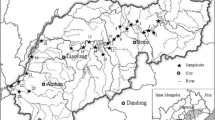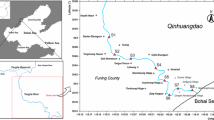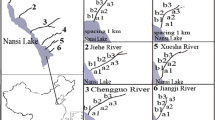Abstract
Lake Taihu, the third-largest freshwater body in China, has many functions, including drinking water supply, flood control, cultivation, navigation, and tourism. In this study, sediment samples were collected at 31 sites from 11 inflow rivers in 2012, to investigate the distribution and concentration of heavy metals copper (Cu), zinc (Zn), lead (Pb), nickel (Ni), and chromium (Cr), and to assess their potential ecological risk. The highest mean concentration was found for Zn, followed by Cu, Cr, Pb, and Ni. Generally, heavy metal pollution was more serious in Wu Jingang River and Caoqiao River, probably because they receive large amounts of wastewater from various local industrial enterprises. The potential ecological risk values of the heavy metals were larger than 120 in more than 25.8 % of the sediment samples, indicating a very high risk. The largest ecological risk was due to copper. Furthermore, the results of a principal component analysis and subsequent analysis of variance showed that heavy metal concentrations in the sediment of inflow rivers were higher than those of the lake, which created a large hazard for the aquatic ecosystems of Lake Taihu.



Similar content being viewed by others
References
Cheng H, Hu Y (2010) Lead (Pb) isotopic fingerprinting and its applications in lead pollution studies in China: a review. Environ Pollut 158:1134–1146
Chi Q-Q, Zhu G-W, Langdon A (2007) Bioaccumulation of heavy metals in fishes from Taihu Lake, China. J Environ Sci 19:1500–1504
Hakanson L (1980) An ecological risk index for aquatic pollution control of sediment ecological approch. Water Res 14:975–1000
Huang H et al (2011) Quantitative evaluation of heavy metals’ pollution hazards in liquefaction residues of sewage sludge. Bioresour Technol 102:10346–10351
Liu N, Ni T, Xia J, Dai M, He C, Lu G (2011) Non-carcinogenic risks induced by metals in drinking source water of Jiangsu Province, China. Environ Monit Assess 177:449–456
Liu E, Birch GF, Shen J, Yuan H, Zhang E, Cao Y (2012) Comprehensive evaluation of heavy metal contamination in surface and core sediments of Taihu Lake, the third largest freshwater lake in China. Environ Earth Sci 67:39–51
MacDonald DD, Ingersoll CG, Berger T (2000) Development and evaluation of consensus-based sediment quality guidelines for freshwater ecosystems. Arch Environ Contam Toxicol 39(1):20–31
Muller G (1969) Index of geoaccumulation in sediments of the Rhine River. GeoJournal 2:108–118
Paulino AT, Minasse FA, Guilherme MR, Reis AV, Muniz EC, Nozaki J (2006) Novel adsorbent based on silkworm chrysalides for removal of heavy metals from wastewaters. J Colloid Interface Sci 301:479–487
Qu WC, Mike D, Wang SM (2001) Multivariate analysis of heavy metal and nutrient concentrations in sediments of Taihu Lake, China. Hydrobiologia 450(1–3):83–89
Tao Y, Yuan Z, Wei M, Xiaona H (2012a) Characterization of heavy metals in water and sediments in Taihu Lake, China. Environ Monit Assess 184:4367–4382
Tao Y, Yuan Z, Xiaona H, Wei M (2012b) Distribution and bioaccumulation of heavy metals in aquatic organisms of different trophic levels and potential health risk assessment from Taihu lake, China. Ecotoxicol Environ Saf 81:55–64
Yao SC, Xue B (2010) Nutrients and heavy metals in multi-cores from Zhushan Bay at Taihu Lake, the largest shallow lake in the Yangtze Delta, China. Quat Int 226:23–28
Yin H-B, Fan C-X, Ding S-M, Zhang L, Zhong J-C (2008) Geochemistry of iron, sulfur and related heavy metals in metal-polluted Taihu Lake sediments. Pedosphere 18:564–573
Yuan H-Z, Shen J, Liu E-F, Wang J-J, Meng X-H (2011) Assessment of nutrients and heavy metals enrichment in surface sediments from Taihu Lake, a eutrophic shallow lake in China. Environ Geochem Health 33:67–81
Zeng J, Zhao D-Y, Huang R, Wu QL (2012) Abundance and community composition of ammonia-oxidizing archaea and bacteria in two different zones of Lake Taihu. Can J Microbiol 58:1018–1026
Zhang L, Sun W, Ye w, Liu W, Wang C (2009) Overall treatment of water environment for inflow rivers of Lake Taihu. Adm Tech Environ Monit 1–5 (in chinese)
Author information
Authors and Affiliations
Corresponding authors
Rights and permissions
About this article
Cite this article
Niu, Y., Niu, Y., Pang, Y. et al. Assessment of Heavy Metal Pollution in Sediments of Inflow Rivers to Lake Taihu, China. Bull Environ Contam Toxicol 95, 618–623 (2015). https://doi.org/10.1007/s00128-015-1654-x
Received:
Accepted:
Published:
Issue Date:
DOI: https://doi.org/10.1007/s00128-015-1654-x




